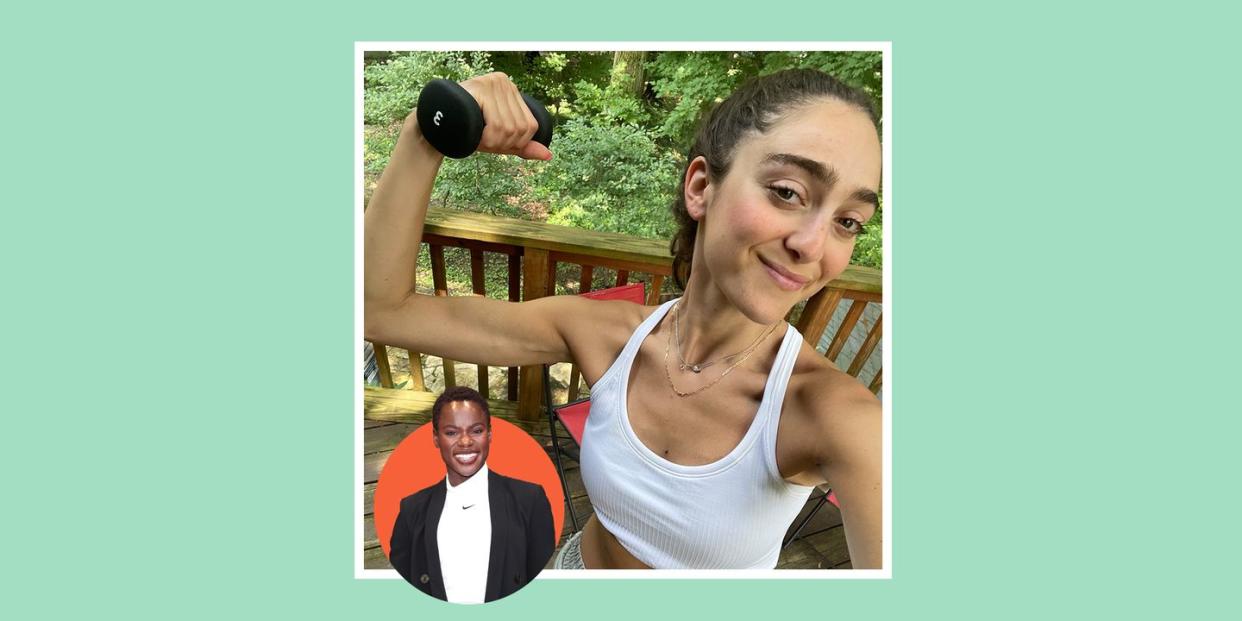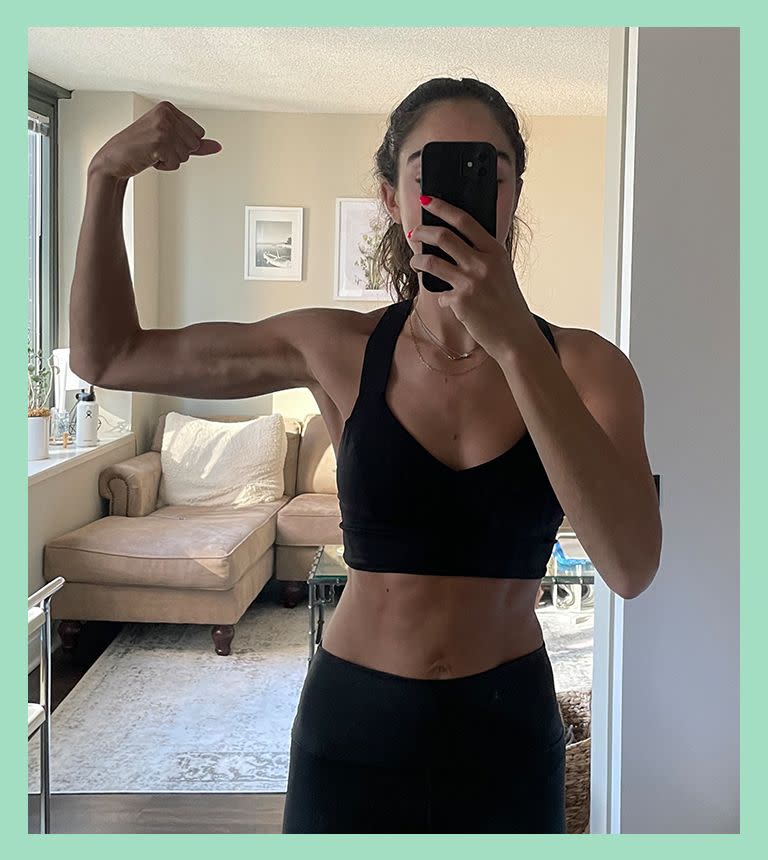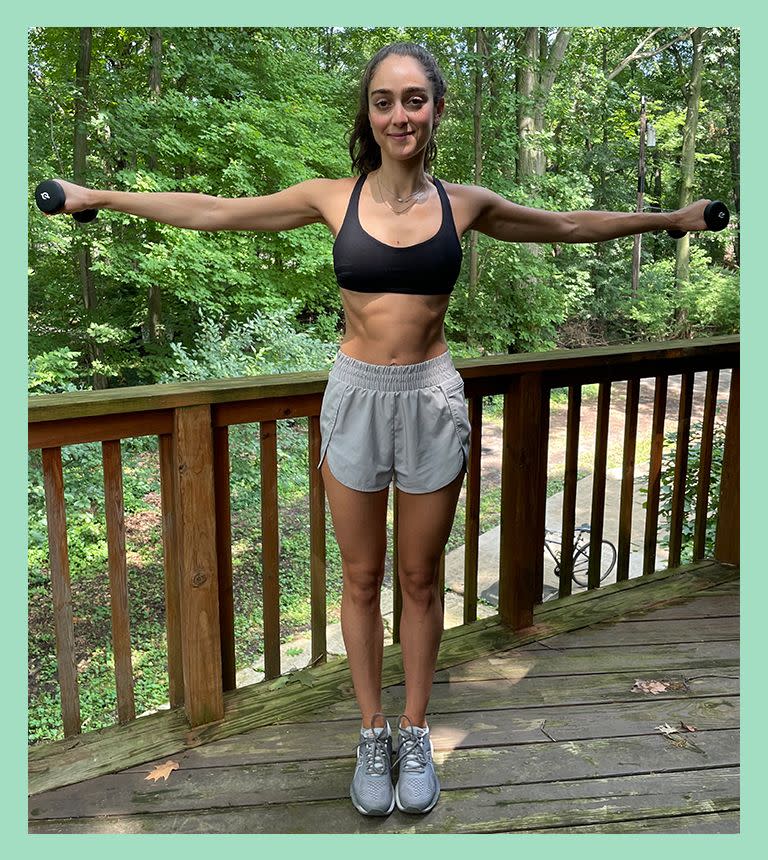'I Tried Tunde Oyeneyin's Arm Challenge For A Month And My Triceps Were Torched'

I’ll be honest. I’m a little obsessed with Peloton. Do I feel like I know the instructors personally? Yes. Are they talking directly to me when they say 'don't drop the weights?' Of course! Do I love getting a gold “badge” for working out multiple days in a row or completing a challenge? Every. Single. Time. (Maybe, I'm a lot obsessed with Peloton.) So, when I agreed to do the Tunde Oyeneyin 10-minute arm challenge, I was all in.
First things first: If you have worked out with Tunde before, you understand her intensity. If you haven't, biceps curls are the “recovery.” (Get it?) But as Tunde likes to say, “the pain today is the change tomorrow.”
So, yes I volunteered for 30 days of pain workouts in the name of changed arms. Tunde's arm challenge consists of a single 10-minute arm workout repeated four times in one week, followed by a new 10-minute arm workout the following week. Tunde's challenge spans 36 weeks (6 months), but I committed to one month. I planned to complete four different 10-minute workouts during four weeks this summer (16 workouts total).
Try Peloton App and Tunde's classes (Free!)
The goal of each class is to tone your upper body, and Tunde recommends using 1 to 3 pound weights. Her method is light weight with high reps, but don’t be fooled. Those 3 pounders still burn. (I mean burn.)
Here's how my arms fared through four weeks of Tunde's arm challenge on Peloton:
The Arm Challenge Workout
One quick note before I get into the details. The arm challenge is informal, you don't sign up on the Peloton app. Instead, Tunde drops new 10-minute arm on-demand workouts a few times a month, shares her directions, and anyone can follow along. (Take a look at one example sweat below.)
10-Minute Arm Workout:
Biceps (3 minutes - Curls, Flipped Grip Curls, Single Arm Curls)
Triceps (2 minutes - Kickbacks, Hold, Pulses, Kickbacks)
Recovery (30 seconds - Hammer Curls)
Triceps (1 minute - Kickbacks, Pulses)
Shoulders (3:30 minutes - Lateral Raise, Slow Lateral Raise, Front Raise, Slow Front Raise, Rotations)
Each routine is based on time, not reps. Tunde directs when to start and stop moves, or when to switch positions and speed. The entire workout is only 10 minutes, there is little-to-no recovery time built in. “Recovery” is a loose term because it really just means switching muscle groups. For example, after working three minutes of triceps, Tunde's version of “recovery” is a shoulder press or biceps curls (or 50).
I followed a scheduled from Peloton members who filled in the blanks with specific class dates (join Facebook groups like Tunde's Army to access). Or, you can filter your Peloton app for strength, Tunde as the instructor, 10-minutes in length, “arms and light weights” as the class type, and then scroll down until you find the correct class date. You can also follow the hashtag #TundeArmy to connect with other athletes committed to the challenge!
The Journey
Week 1: I started with ambitious weights and allowed myself rest breaks.

My usual routine includes a decent amount of upper-body strength training, so I started out with 3 lb dumbbells. I wanted to push myself from the start and gauge my progress on a consistent weight scale. But you could absolutely do the routine (class date 5/29/20) with lighter weights or bodyweight. Trust me, with Tunde leading the charge, you will still feel the burn.
The first week of the challenge, I completed the arm routine before any other exercise. I wanted to see how my body felt from the workout alone, without adding other exercise into the mix. As anticipated, Tunde is not messing around. The first minute is a light warm-up to stretch and loosen the muscles, and the following nine minutes are straight work. While the program is a total upper-body workout, the moves primarily focus on biceps, triceps, shoulders, and back, targeting each muscle group fairly equally.
The exercises were easy to learn. Nothing else was easy, though.
TBH, the first two times I attempted the workout, I did not make it through without any rest. On both days I took a quick break five minutes in amid lateral raises. I wanted to stay focused on quality and not compromise my form, so a quick shake out was necessary. I was able to resume the moves and the burn for the duration of the workout. By the end, my arms felt like noodles barely able to hold the dumbbells.
On day three, I got used to the movement patterns and accustomed to the high reps. On the last two days of the week, I was able to make it through the entire class without resting. It was hard and there were times when I really wanted to take a quick rest, but I stayed strong. Literally!
Week 2: I combined runs with the arm workouts.

By the second week I was excited for a new routine and new music (class date 1/14/20). This time, I decided to complete the challenge after my usual cardio workouts. As a mid-distance runner, I ran my usual four to five miles first, and then completed Tunde’s arm routine. And let me tell you, I absolutely noticed a difference. While running is notoriously lower-body focused, I do try to focus on my arm form to max speed and energy. Pumping my arms doesn't seem like a tough workout in the moment, but I definitely felt more fatigued when I picked up the weights.
In particular, my triceps were torched. Tunde loves to incorporate triceps extensions, holds, and pulses. After the first circuit, I had to rest for a few seconds. I felt my triceps quivering.
But in good news, my shoulders and biceps felt stronger. My front and side lateral raises felt more stable, and the lengthy circuit of “serve the platter” moves (which works your shoulders and biceps) felt easier.
As a surprise bonus, I also felt my core engage more. Tunde cues maintaining a tight, strong core strong during the bent over triceps extensions and lateral raises. I could totally feel my core working.
Week 3: I finally experienced a breakthrough with new moves.

I had my first true breakthrough this week. Usually, on the first day of a new week (new class date 12/21/19) my body has to adjust, and my muscles are a little stunned. But this week, I felt noticeably stronger (I even texted my mom who is on week 18 of the challenge to tell her!).
While I continued to do the workouts after cardio, hammer curls felt much easier, my endurance during cross-body punches improved, and triceps holds and pulses, which are notoriously my weakest link, didn’t feel as tough. Basically, the whole workout felt a bit less challenging. I felt strong and proud at the end of each one.
Week 4: I saw measurable stability and strength progress repeating the class I started with.

Week four of the challenge was the same class as week one (class date 5/29/20). At first, I was a little bummed that I would be repeating it. That actually turned out to be the perfect test of my progress. I was able to compare my strength and ability four weeks apart while completing the exact same workout.
Right after the class I immediately noticed my biceps were stronger. The biceps curl “recovery” actually felt more like a recovery! The triceps extension pulses still burned (a lot) but I felt more confident and stable.
By the end of week four, my upper body was feeling stronger than ever, and I saw new muscle definition in my biceps, shoulders, and front delts. I also noticed that my core felt tighter and maybe a looked little more toned.
My Biggest Takeaways

1. Ten minutes is longer than you think.
Yes, it may seem like a quick workout, but Tunde makes sure to maximize your time. Because there is little recovery and the goal is to keep moving the entire time, your arms are definitely fatigued by the end and likely to be sore in the morning! The low weight, high rep model is the perfect way to get a quick burn.
2. Using light weights does not mean it’s easy.
I cannot stress this enough. Do not be fooled by the number on the dumbbells. Even though it’s a lighter weight, my arms were quickly tired due to the high reps. After all, studies show that scaling back on weight while increasing reps helps increase fast-twitch muscle fibers which support quick and powerful movements in a short amount of time.
3. Consistency is key.
I won’t lie, I was a little nervous at first to do the same workout four times a week. I thought it would get easy and become boring. I was certainly wrong. I quickly learned to love the consistency and appreciated having a way to track my progress. Also, if I was ever tired or had an off day, I knew I had more attempts at the same workout to improve.
4. Real strength gains are possible in four weeks.
At the end of my shortened challenge, I absolutely noticed and *felt* a difference in my upper-body strength. Even on days I didn’t want a full training sesh, this 10-minute class was the perfect bite-sized workout. Plus, Tunde’s high energy, words of encouragement, and fun playlist always made me smile. I never wanted to miss out. I definitely worked out more frequently having the speedy exercises on my schedule.
Bottom line: I loved the structure and consistency of the workouts. I saw some serious results, and I would absolutely recommend giving this challenge a shot.
You Might Also Like